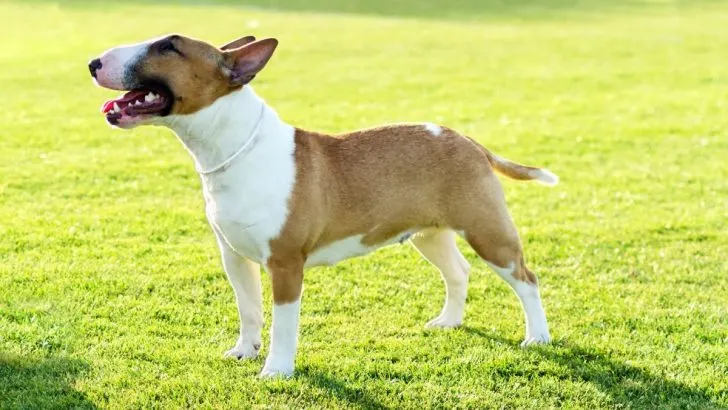This dog breed is easily recognizable by their unique and remarkable look, including the robust and muscled body topped off with the distinctive egg-shaped head.
But another captivating aspect of the breed is the Bull Terriers Colors. This high-energy breed of dog has many variants of striking coat colors.
They range from elegant white to rich brindle and vibrant tricolors, helping each dog in this breed to be distinctive and visually intriguing.
The captivating coat colors of the Bull Terrier reflect the breed’s individuality and spirited personality.
The Bull Terrier can live well with young children and other animals if socialized early and adequately. They even showed they were cautious and sensitive dogs around the family kids.
In terms of temperament, this dog breed is friendly, outgoing, and sociable. However, they are not recommended for novice dog owners because Bull Terriers need additional training compared to other dog breeds.
However, if you have never had a dog and still decide to go for a happy pup of this breed, contact a dog trainer for a consistent training schedule and training tips
The Bull Terrier Coat Colors
The Bull Terrier breed colors are categorized into two color combinations: white and colored. Yet, this remarkable breed has a broad spectrum of coat color combinations.
This never changed since the 1800s when the breed got its first official standard. The most significant thing in the standard was the shiny, porcelain-like coat of the Bull Terrier.
Thanks to their short, shiny coats, this breed does not care about cold weather since these pups are bred for hot weather and climate.
During the freezing temperatures, these dogs prefer apartment living over dog sports, but they still require ample exercise, outdoor activities, and mental stimulation.
This detailed analysis will take a closer look at all the Bull Terriers Colors and patterns.
1. The White Bull Terriers

The white coat embodies a Bull Terrier’s look, signifying elegance and innocence. These dogs have a solid white coat without any markings.
The white coat is the most typical and well-known color for Bull Terrier dogs. Its classic beauty has made it a favorite among breed enthusiasts, showcasing its classic and iconic appearance.
The white Bull Terrier is the earliest one. Bull Terriers were bred to be pure white since they are descendants of the White English Terrier that was entirely white.
The difficulty in the past was that the white coat needed to be entirely white without any additional markings.
If a white Bull Terrier pup had any markings, it was considered a mismark according to the breed standard, and the pup was not allowed to compete.
After years had passed and various factors were at play, some markings were allowed. Yet, the dog was allowed to have markings only on the head, and they needed to be small in size and mainly around the eyes and the ears.
However, even today, if a pup is to be considered a solid white Bull Terrier, they can not have any discoloration of the body or neck.
2. The Red Bull Terrier

Red Bull Terriers are often called Ginger Bull Terriers. This type of Bull Terrier has a stunning color that can be rusty, orangey, or brownish.
The color can be a bit lighter or a darker shade of brown or red. These dogs can come in solid red color. This means that their whole body is red.
However, even though they are deemed solid red, some white markings will still be on this type of Bull Terrier. Those white patches are small and extremely hard to see occasionally, but they are present.
However, in the red category of this breed, there are more sub-categories.
3. The Red Smut Bull Terrier

The red smut Bull Terrier is nearly the same as the solid red Bull Terrier. Some call them Red Bull Terriers, and we can’t blame them – the difference is occasionally challenging to notice.
When you catch the phrase ‘smut’ in the name following a color, it means the dog has a darker snout. And precisely, that is the case with the red smut.
These Bull Terriers are a solid red color with a darker muzzle. The shade of the muzzle can vary, and sometimes, the darkness is effortless to notice, while at other times, it is harder to determine because the shading is very light.
4. The Red Smut With White Bull Terriers
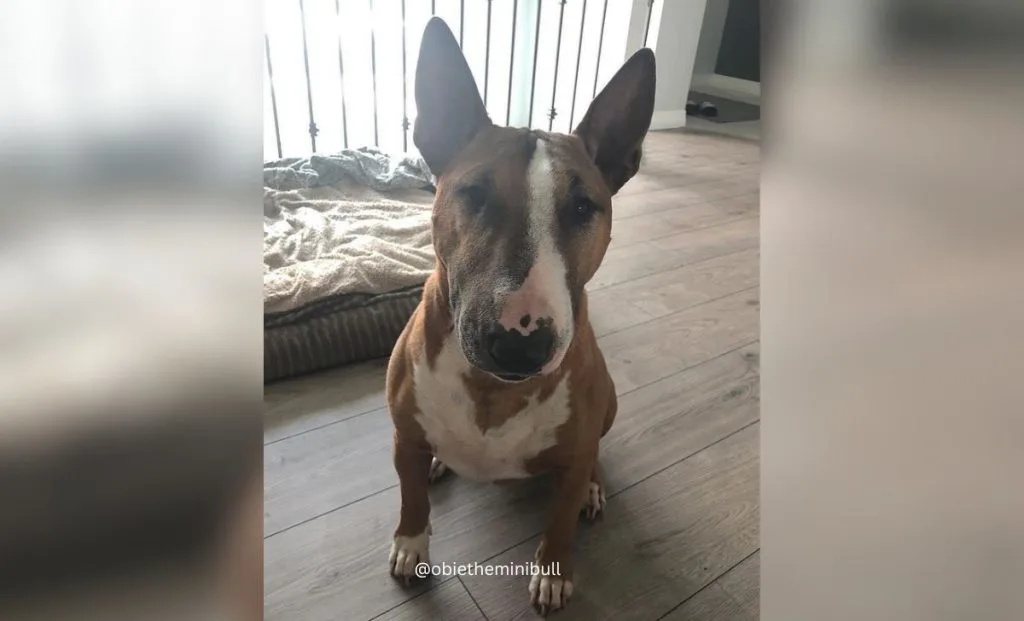
As discussed, solid red Bulls have hardly noticeable markings, while red smut with white means the have a more prominent, noticeable white marking.
This variety is not especially pronounced when they are young pups primarily because of the snout that usually darkens with age.
5. The Red With White Bull Terriers
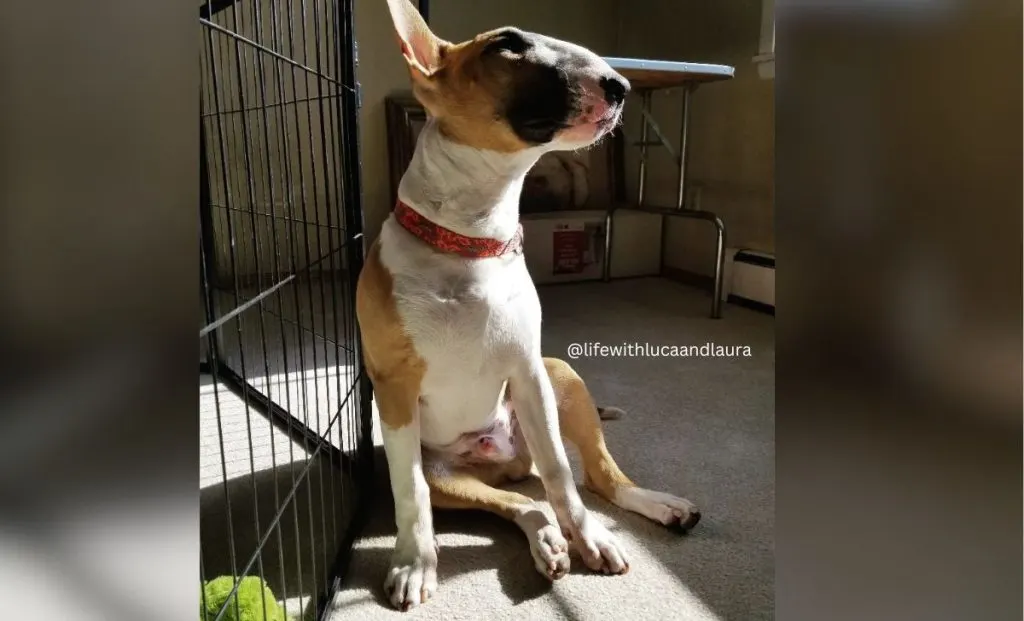
The red and white combination is the same as the red smut with the white minus the smut part.
The coat shade of these dogs is predominately red, with white patches on the head, muzzle, paws, and belly.
6. The Fawn Bull Terriers
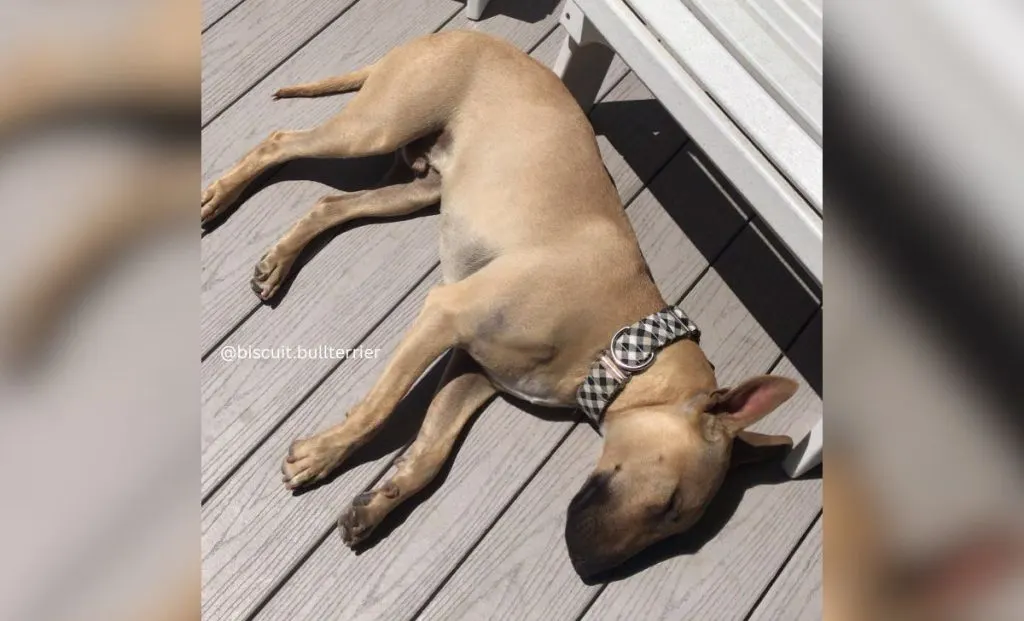
Fawn Bull Terriers can be overlooked and are sometimes dubbed as the “red little sisters.”
They closely resemble red Bull Terriers but are slightly lighter, akin to a sandy color.
When comparing red and fawn Bull Terriers side by side, the difference may be noticeable. However, it can be challenging to determine if they are red or fawn when seen individually.
Fawn Bull Terriers can have solid options without any white markings.
White Bull Terriers With Markings
While primarily white, these Bull Terrier dogs may have markings of a different color on the body or the head. Typical markings contain black, brindle, or fawn patches.
White Bull Terriers with markings on their furs are also reasonably popular, as the contrasting markings add a flicker of individualism to their look.
7. The White With Red Bull Terriers

If you think we have already gone through this, white with red and red with white dogs differ. When talking about white with red Bulls, the base color is still white, but they have several red markings.
However, if you look at the red with white Bulls, you can notice the base color is red, and the white spots are large.
Sometimes, the difference is unnoticeable, while you can notice it other times.
8. The White With Red Smut Bull Terriers
A white with red smut is nearly the same as a red with white smut – the difference being the snout.
These Bull Terrier dogs look like they have found some charcoal and agreed to sniff it.
The red spots are still present, but the muzzle on the dog is noticeably darker. This variety is a bit rarer than the rest.
9. The White With Brindle Bull Terriers
White with brindle indicates a dog with a white body and neck, while the eyes and ears carry the brindle pattern.
10. The White With Black Brindle Bull Terriers
The white with black brindle combination is nearly identical to the white with brindle coloring.
The black brindle also carries the name reverse brindle.
The main difference between the brindle and the reverse brindle is that the pattern is darker with the reverse (or black brindle).
11. The White With Fawn Bull Terriers

White with red Bull Terriers and white with fawn are similar, if not almost the same.
The white fawn Bulls have fawn markings on their ears and eyes but none on their body.
The red and fawn markings are more or less the same for people who are not dog experts or Bull Terrier breed aficionados.
12. The White With Fawn Smut Bull Terriers
These pups have fawn markings on their head, and their muzzle is darker than the rest of their body.
As with the other types, their body is solid white.
13. The White With Black & Tan Bull Terriers

The white with black and tan pups have primarily tan markings, with a touch of black.
The markings are next to each other.
The Brindle Pattern In Bull Terriers
Brindle refers to a coat pattern distinguished by dark lines on a lighter background color.
Bull Terriers with brindle coats display these fascinating black, brown, or blue stripes.
Brindle-coated Bull Terriers are highly pursued due to their beautiful and eye-catching appearance.
14. The Brindle And White Bull Terrier
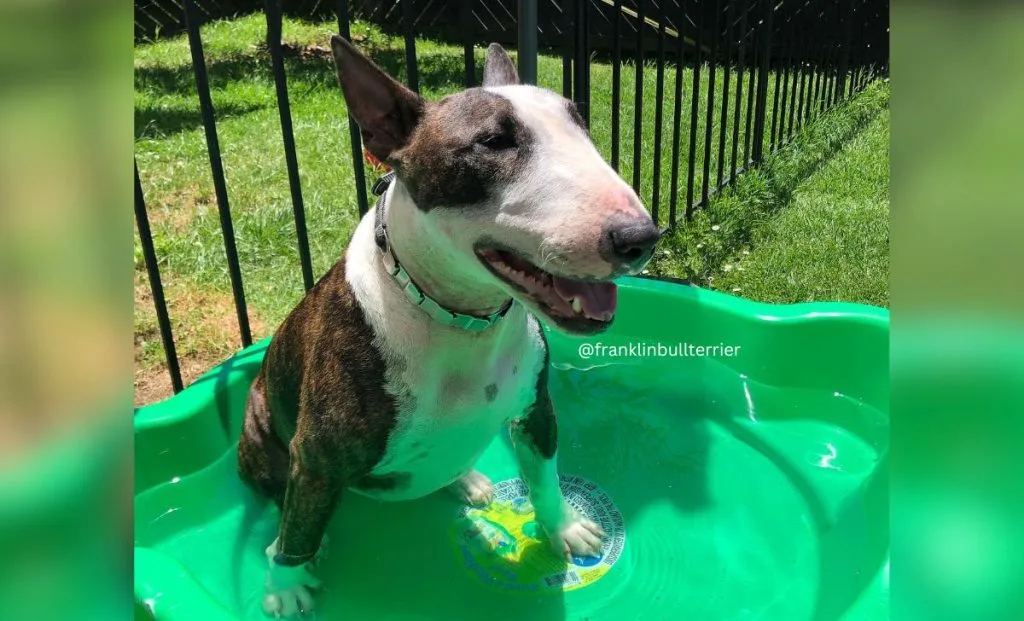
This coat color showcases a blend of brindle patches or lines and the traditional white-colored coat.
The brindle patterns might vary in intensity and range.
The brindle and white Bull Terriers are popular among dog lovers who enjoy the fusion of patterns and the remarkable contrast they deliver.
15. The Black Brindle With White Bull Terriers
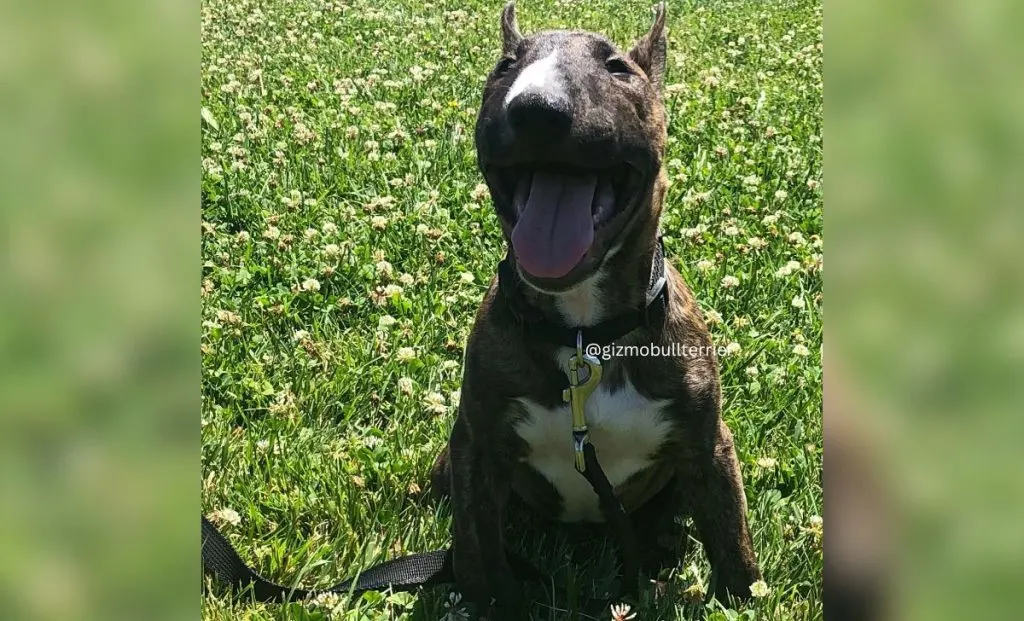
The black brindle with white color is the same as the brindle with white coloring; only the brindle color is darker.
The brindle portion will be brown, while the base shade will be black.
Rare Coat Colors In Bull Terriers
Bull Terriers periodically display rare coat colors that are less frequently seen.
These might contain extraordinary combinations like blue, liver, or even merle patterns.
Due to their rarity, Bull Terriers with unusual coat colors attract significant attention from breed aficionados looking for something unique.
16. The Liver Bull Terriers
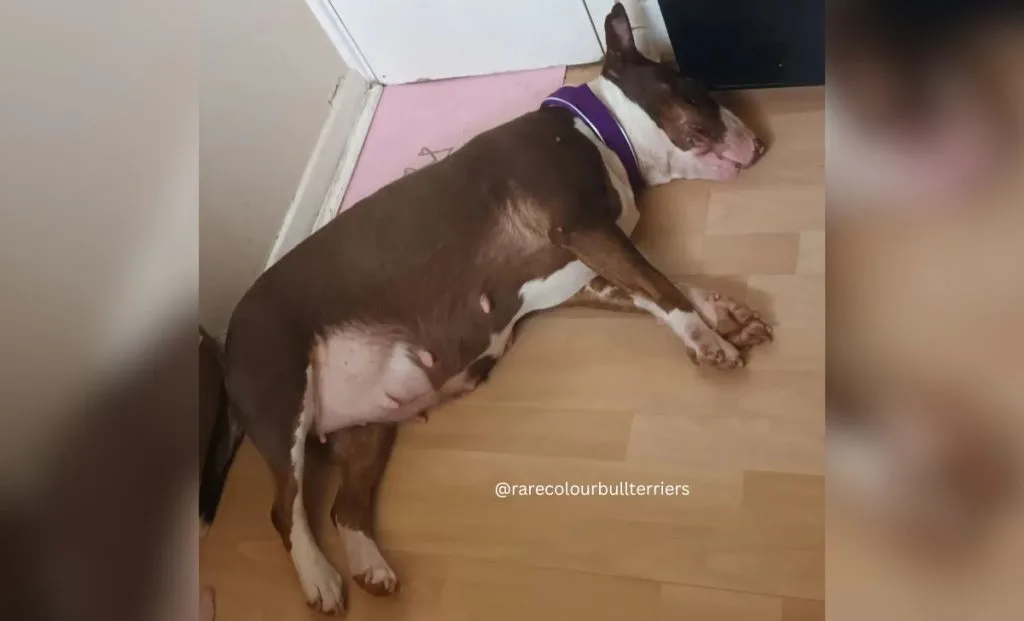
The term “Liver” refers to a gene that affects pigmentation in dogs, particularly by extracting black color.
It’s not a standalone color but can alter a white Bull Terrier’s appearance. Besides changing the fur coat, the Liver gene affects the nose, lightening it to a reddish or maroon hue and lightening the eyes to a yellowish-green shade.
In colored Bull Terriers, it lightens the entire coat, particularly noticeable in brindle or tri-colors.
Reds may appear slightly lighter with an orange tint, and smut markings may darken to an orange or maroon shade.
17. The Merle Bull Terriers
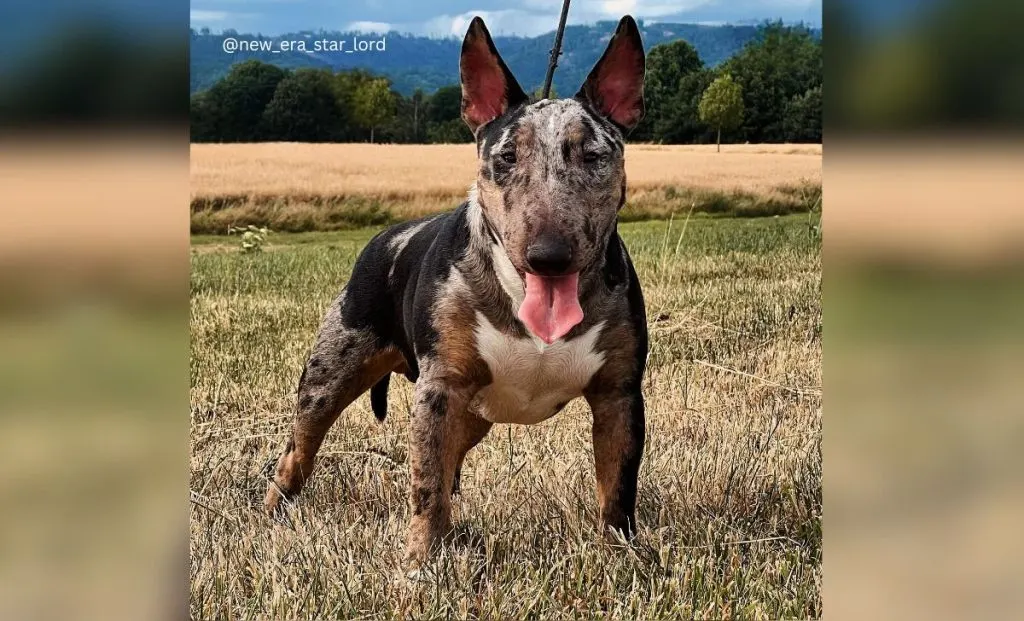
Merle coat color/pattern in dogs is inherited dominantly, meaning just one copy of the M allele can lead to variations in coat color.
It dilutes black pigment in patches, leaving some areas with standard color. This allele mainly affects black pigment areas, not red/yellow ones.
The patchy look comes from unstable M alleles in skin cells, which may express color differently. Different sizes of M alleles lead to different merle coat colors/patterns.
Two large M alleles can cause skin, eye, and ear issues, including significant white areas in the coat, eye problems, and deafness.
Coat Marking Patterns in Bull Terriers
Bull Terriers’ coat patterns and markings add a layer of identity and charm to their appearance.
From the traditional all-white fur to the fun brindle and white combinations, these pups showcase an assortment of striking patterns.
In this section, we will investigate the typical color patterns in Bull Terrier dogs, shedding light on the areas where markings typically appear.
Head Markings
Bull Terriers frequently display markings on their heads, adding a flicker of character to their appearance. Size, color, and shape deviations happen with these markings.
Some Bull Terrier dogs have a solid-colored head with no markings, while others have markings around the eyes, forming a specific mask-like pattern.
It is not unusual to see Bull Terriers with a blaze, an upright line running down the center of their forehead, further enhancing their unique look.
Body Markings
In addition to head markings, Bull Terriers also have markings on their bodies.
These markings commonly occur on the dog’s sides, flanks, or back.
They can take the form of spots, patches, or brindle striping. The markings can vary in shape, size, and intensity from pup to pup.
Legs And Tail Markings
The legs and tails of these dogs might also have markings, although they are less ordinary than the head and body.
Some Bulls may have solid-colored legs or tails sans any markings, while others have partial or complete markings in the form of spots or stripes.
These markings can make a fascinating contrast against the base fur color.
In Conclusion
Bull Terriers are quite an unusual dog breed. Their look is something you either love or don’t. But honestly, I can not wrap my mind around the thought that someone won’t fall in love with that cute face.
Many people adore them, and you can find a Bull Terrier club in almost every country.
The important thing I would like to add is that the coloring of a dog should not be the main reason for getting a dog.
Every breed has some attractive colors and markings, but the temperament of the dog is what should make you want to get one.
Before you go and get a gorgeous brindle Bull Terrier, please educate yourself further on the needs of this high-energy dog breed.

Nandina has been a lifelong dog owner and enthusiast. She shared her home with multiple breeds, including Giant Schnauzers, Cane Corsos, and Huskies. Currently, she is raising a three-year-old rescue and a working-line German Shepherd puppy.
Actively engaged in IGP dog sports for two years, Nandina is a certified instructor for basic obedience and socialization. She works as a trainer in her local dog sports club, and in her spare time, she handicrafts biothane gear for dogs.
